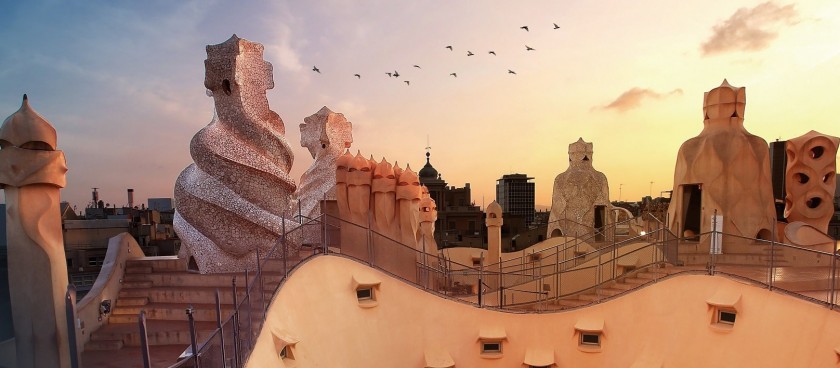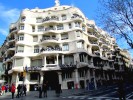- #ES02
- Passeig de Gràcia, 92 08008 Barcelona, Spain
- +34932142576
- info@lapedrera.com
- http://www.lapedrera.com/en
- Working hours*:
March 1 - November 3
Monday - Sunday: 9:00 - 20:30
Night tour: 21:00 - 23:00
November 4 - February 28
Monday - Sunday: 9:00 h - 18:30 h
Night tour: 19:00 h - 21:00 h
December 26 - January 3
Monday - Sunday: 9:00 - 20:30
Night tour: 21:00 - 23:00 - Prices*:
Adult - 22,00€
Children (7-12 years) - 11,00€
Children (0-6 years) - Free
Student - 16,50€
Disabled - 16,50€
Senior (+65 years) - 16,50€ - * - opening and closing times as well as entrance prices, are subject to alterations without notice. Visitors are advised to check before visiting.
- Estimated visits: 1h/1h30m
Close upper floors: 15 minutes before building closure - 41.3953830, 2.1619610 Copy to clipboard Copy
-
#Museums
Barcelona 1900
In the year 1900, Passeig de Gràcia was the most important avenue in Barcelona. It was here that iconic buildings began to spring up, and the finest theatres and cinemas, and the most exclusive shops, restaurants and cafés opened.
It was also the boulevard on which the wealthiest and most ambitious members of the bourgeoisie decided to build their homes, vying with each other in a bold and exhibitionist manner by commissioning the most eminent architects of the day to undertake their projects.
A home for Pere Milà and Roser Segimon
In 1905, Pere Milà and Roser Segimon married. Attracted by the fame of Passeig de Gràcia, they purchased a detached house with garden situated on a plot measuring 1,835 square metres and they commissioned the architect Antoni Gaudi to build their new property. The main floor of this new building, Casa Mila, was to be their home and they would rent out the other apartments.
The construction (1906-1912)
There was considerable interest in the construction of Casa Mila and various reports about it were published, such as the piece in L'Edificació Moderna, magazine, the publication of the construction employers’ association.
The article stated that Gaudi was determined to meet the needs of modern life “without the nature of the materials or their resistance being an obstacle that limits his freedom of action”, and it described the structure of columns as an innovation that would result in large and well-lit spaces.
The construction of the building was complex and was fraught with financial and legal problems. Nor was it free from controversy. Gaudi kept changing his projects to shape the appearance the structures of the building as the work advanced. He went well over the expected budget and did not abide by the City Council’s building codes: the built volume was illegal; the attic and the rooftop exceeded the permitted maximums; and one of the pillars of the façade occupied part of the pavement on Passeig de Gràcia.
When Gaudi discovered that an inspector had been by to alert the builder, Mr. Bayó, to these illegalities, he left very precise instructions. If the inspector came back and the column had to be cut, Gaudi would have a plaque put up, stating “the section of column that is missing was cut at the order of the City Council”.
In the end, the Eixample Commission certified that the building was a monument in nature and did not need to conform strictly to the municipal bylaws. Even so, the Milàs had to pay a fine of 100,000 pesetas to legalise the building.
The Milàs argued with Gaudi over his fees and they even went to court over them. Gaudi won the case and Roser Segimon had to mortgage Casa Mila to pay the architect, who donated the compensation to a convent of nuns.
Satires
La Pedrera’s unusual structure and the relationship between Antoni Gaudi and Pere Milà were the subject of public mockery and ridicule and were frequently caricatured in cartoons in numerouss satirical publications of the time.
The first tenants
In the early years, advertisements were published in La Vanguardia newspaper, offering rooms to rent in Casa Mila, looking for servants for one or other of the tenants, and even advertising English classes with a teacher named Miss Dick.
The tenants included: the Pensió Hispano-Americana (1912-1918); Alberto I. Gache (Buenos Aires, 1854 - Montevideo, 1933), consul of the Argentine Republic to Barcelona, who lived at apartment 1r 2a from 5 August 1911 to the end of 1919; Mercè Duran and Paco Abadal, who moved into apartment 3r 1a and lived there from 1912 to late 1930; the Egyptian prince Ibrahim Hassan (Cairo, 1879 - Barcelona, 1918), who died in his home in La Pedrera on Passeig de Gràcia; and the Baladia family, textile industrialists who rented apartment 2n 2a on Carrer Provença as a pied-à-terre, a practical and small central flat where they could spend the night after they had been out late at the Liceu opera house, the Palau de la Música concert hall, the theatre or a celebratory event in Barcelona.
In 1929, shops started to open in the ground floor of the building, among them the famous Sastreria Mosella tailor’s shop, which remained there for over 80 years.
In 1946 Roser Segimon, who by now had been a widow for six years, sold the building to the Immobiliària Provença real estate company, though she continued to live in the apartment on the main floor until her death in 1964.
Recent history
After many years of neglect, Casa Mila, popularly known as La Pedrera and declared a World Heritage Site in 1984 by UNESCO, was restored and opened to the public in 1996.
Since January 2013, the building has been home to the Catalunya La Pedrera Foundation and a major cultural centre that is renowned in Barcelona for the range of activities it organises and the various museum spaces and rooms for public use that it provides.


